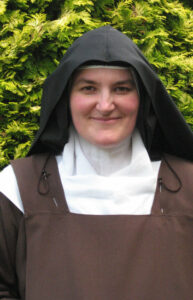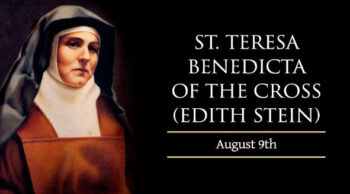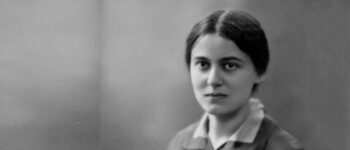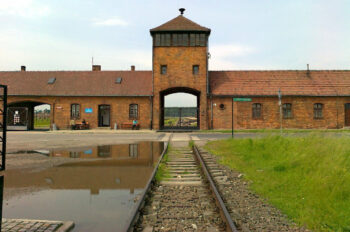Edith Stein – St Teresa Benedicta of the Cross

By Sr Cushla Renton OCD
One hundred years ago, on New Year’s Day 1922, 30-year-old Jewish philosopher Edith Stein was baptised in Bergzabern, Germany. Two decades later she would be killed in Auschwitz, and eventually be canonised as Saint Teresa Benedicta of the Cross.
Early Life
Edith was born on 12 October 1891 in Breslau, Germany (now Wroclaw, Poland). She was the youngest of seven children in a Jewish family. At an early age she showed an independence of spirit and love for learning. She asked to be allowed to start school before the normal entrance age, did exceptionally well, and then surprised everyone by asking to leave when she was fourteen. About this time she ceased to believe in a personal God and stopped praying. But God was not finished with her. Her search for truth had begun. Recommencing her education the following year, she completed High School and began studies in German, History and Psychology at Breslau University.
Phenomenology
In 1913 her thirst for truth led her, after reading a book by Edmund Husserl, to the University of Göttingen. There she delved into phenomenology, a new branch of philosophy, which sought to bracket off presuppositions and prejudices and get to the essence of things. Her studies were temporarily cut short when World War I began, sending the young male phenomenologists into the army. Edith, not content to study while her friends were engaged in battle, trained to nurse, and worked in a hospital at the front, caring for soldiers with infectious diseases. When her nursing stint came to an end, she resumed her studies. She eventually graduated PhD, with highest honours. She worked as Husserl’s assistant for 18 months, then unsuccessfully sought an academic position. Finally, she pursued her own research and taught privately.
 Openness to Faith
Openness to Faith
While at Göttingen Edith examined phenomena as they arose, and this opened her up to the life of faith. Attending lectures on the phenomenology of religion by the philosopher Max Scheler, she wrote: “This was my first encounter with this hitherto totally unknown world. It did not lead me as yet to the Faith. But it did open for me a region of “phenomena” which I could then no longer bypass blindly. […] The barriers of rationalistic prejudices with which I had unwittingly grown up fell, and the world of faith unfolded before me. Persons with whom I associated daily, whom I esteemed and admired, lived in it. […] I was content to accept without resistance the stimuli coming from my surroundings, and so, almost without noticing it, became gradually transformed.”
It was many years before this openness led her to faith. Her teacher and friend, Adolf Reinach, and his wife, Anna, were baptised early in 1916. When he died in the War the following year, Anna asked Edith to arrange his papers for possible publication. Edith was stunned to see this woman remaining calm and serene in the face of such a loss. Such witness edged her closer to a decision, but several more years were to elapse before she got there. Reading St Teresa of Avila’s Life in 1921 inspired Edith to become a Catholic; she began 1922 at the baptismal font, taking the name ‘Teresa.’ She had found the truth she had long sought, and, like St Teresa, discovered it was a Person, Jesus Christ.
 After Baptism
After Baptism
Just over 20 years remained of her life. How did she live out the truth she had discovered? Her initial desire to be a Carmelite nun was put on hold. It was difficult enough for Edith’s mother that her daughter was now Catholic, and she didn’t want to inflict more suffering upon her. Also, her directors could see that her intellectual talents could be used in the Church. Edith found employment in a Dominican convent school and remained there for 8 years, teaching German and literature. Many wrote to her asking her advice and hundreds of letters survive, attesting to her wisdom and common sense. During this time she translated works of John Henry Newman and Thomas Aquinas and was eventually asked to give talks around Europe on women’s issues and education. Brilliance aside, the one thing she wanted to leave with her hearers was how to live at the hand of the Lord, that is, living a life of total dependence on God.
We can see her putting this into practice herself. In 1932 she finally gained a position as a lecturer, at the German Institute for Scientific Pedagogy in Münster. When the Nazis took over Germany in 1933 and Jews were banned from holding teaching positions, she would write to a correspondent: “Don’t worry about me. The Lord knows what he has in mind for me.” She could now follow her initial desire to become a Carmelite nun.
Carmel
On 14 October 1933, aged 42, Edith entered Cologne Carmel. Here she entered deeply into a life of prayer. Her superiors asked her to continue writing. She made her Final Profession in 1938, but later that year the worsening situation in Germany forced her to flee to Echt Carmel in Holland. When the Nazis invaded that country in 1940, she had to again seek refuge. This time it was too late.

Auschwitz II, Birkenau – the ‘Gate of Death – gatehouse.
The train track, operating from May to October 1944,
led directly to the gas chambers.
Death
On 2 August 1942, Edith was arrested by the SS as she began her evening hour of silent prayer. She and her sister Rosa were taken to a transit camp. While all around were understandably distraught, Edith remained calm, but sorrowful, caring for the children whose mothers were too distressed to do so. Later that week they were transported to Auschwitz, where they were killed on 9 August. Her final letter, written 3 days before she died, contained the words: “so far I have been able to pray gloriously.” Her search for truth had led her to live fully, regardless of her circumstances.
St Teresa Benedicta of the Cross, pray for us!
Sources:
Life in a Jewish Family – Edith Stein
Self-Portrait in Letters – Edith Stein
Edith Stein: A Biography – Waltraud Herbstrith
 Entries(RSS)
Entries(RSS)